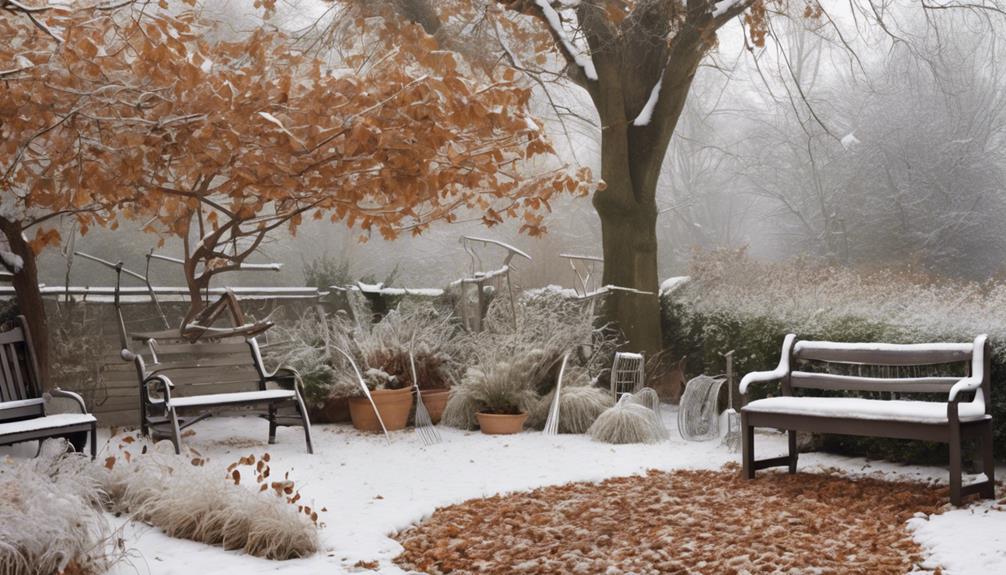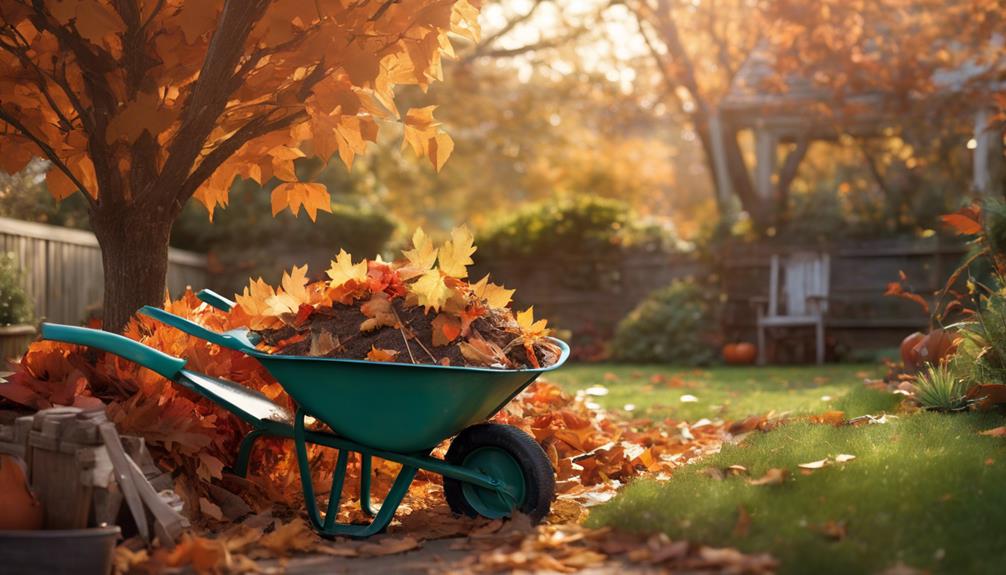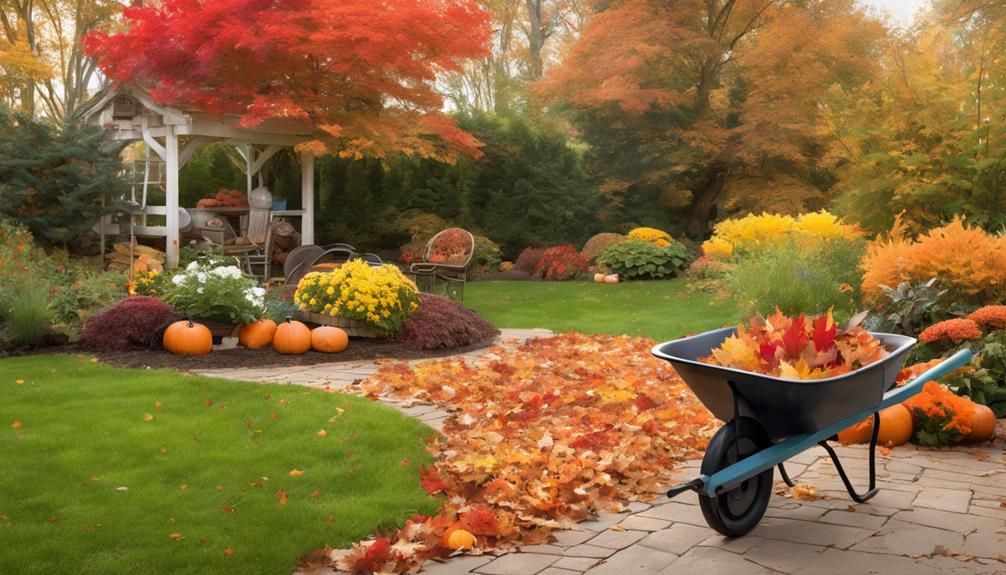
Winter Garden Cleanup: Steps for a Fresh Start
12 October 2024
Top 10 Tips for Flower Bed Cleanup
13 October 2024Effective winter garden cleanup is crucial for spring success.
Begin by assessing the health of your perennials and pruning any dead or diseased foliage.
Utilise essential tools such as sturdy gloves, a high-quality rake, and pruning shears for efficient debris removal.
Conduct soil tests to check pH levels and enrich with organic matter when necessary.
Apply mulch to retain moisture and protect plant roots from the cold.
Furthermore, clean and store your tools to ensure they are ready for the next season.
For comprehensive strategies on enhancing your winter gardening practices, there is much more to explore.
Winter Garden Cleanup Essentials
To effectively undertake winter garden cleanup, a well-prepared toolkit is crucial.
This includes a comprehensive checklist of essential tools to ensure all necessary equipment is at hand.
Furthermore, understanding seasonal plant care will aid in the proper maintenance of your garden during the colder months.
Essential Tools Checklist
As winter approaches, preparing your garden for the colder months requires a specific set of tools to ensure an efficient and thorough clean-up.
Begin with a sturdy pair of gloves to protect your hands from debris and the cold. A high-quality rake will assist in gathering fallen leaves and other organic matter, while pruning shears are essential for cutting back perennials and removing dead branches.
A trowel allows for precise digging when removing spent plants. Consider using a wheelbarrow for transporting debris to compost heaps or disposal areas.
Ultimately, a garden fork can help aerate the soil, ensuring it remains healthy for spring.
Equipping yourself with these tools will streamline your winter garden clean-up and promote optimal garden health.
Seasonal Plant Care Guide
Winter brings unique challenges and opportunities for garden care, necessitating a focused approach to plant maintenance. During this season, it is essential to assess the health of perennial plants and prepare them for dormancy.
Begin by pruning dead or diseased foliage, which can harbour pests and diseases. Mulching around the base of plants not only conserves moisture but also protects root systems against freezing temperatures.
Furthermore, consider implementing protective barriers such as frost cloths for tender varieties. Regularly monitor soil moisture levels, as winter winds can lead to desiccation.
Soil Preparation Techniques
Effective soil preparation is vital for a thriving winter garden, and several techniques can enhance its quality.
Mulching not only aids in moisture retention but also protects the soil structure during the colder months.
Furthermore, conducting soil pH tests and incorporating organic matter are key steps to ensure ideal nutrient availability and comprehensive soil health.
Mulching for Moisture Retention
How can gardeners effectively improve soil moisture retention during the winter months? One highly effective method is mulching. A proper mulch layer not only conserves moisture but also regulates soil temperature and suppresses weeds.
To ensure optimal results, consider the following techniques:
- Select Appropriate Mulch: Choose organic materials such as straw, wood chips, or shredded leaves that decompose over time, enriching the soil.
- Apply Adequately: Spread a 5-10 cm layer of mulch around plants, avoiding direct contact with stems to prevent rot.
- Monitor Moisture Levels: Regularly check soil moisture beneath the mulch to adjust watering needs as necessary.
- Replenish as Needed: Refresh mulch annually to maintain its effectiveness and ensure continuous moisture retention.
Implementing these strategies will significantly improve your garden's resilience throughout winter.
Soil Ph Testing Importance
Maintaining ideal soil conditions is critical for healthy plant growth, particularly during the winter months when environmental stressors can impact soil quality.
Conducting a soil pH test is fundamental for determining the acidity or alkalinity of your garden soil, which directly influences nutrient availability and microbial activity.
Consider the following points regarding soil pH testing:
- Nutrient Availability: Different plants require specific pH levels for optimal nutrient uptake.
- Soil Microbiology: A balanced pH supports beneficial microorganisms that are vital for soil health.
- Amendment Planning: Test results guide the application of lime or sulphur to adjust pH levels.
- Seasonal Preparation: Testing in winter allows for timely amendments before the growing season begins.
Implementing these practices ensures a thriving garden environment.
Organic Matter Incorporation
Incorporating organic matter into garden soil is crucial for improving its structure and fertility, particularly during winter clean-up.
This practice not only enhances soil aeration and moisture retention but also stimulates microbial activity necessary for healthy plant growth.
To effectively incorporate organic matter, consider the following techniques:
- Compost: Apply a layer of well-decomposed compost to enrich soil nutrients and improve texture.
- Green Manure: Plant cover crops, such as clover or rye, to fix nitrogen and add organic material when tilled under.
- Mulching: Spread organic mulches, like straw or shredded leaves, to suppress weeds and maintain soil temperature.
- Manure: Use well-aged animal manure to enhance nutrient content and improve soil structure.
Implementing these strategies will greatly benefit the long-term health of your garden.
Winterizing Tools and Equipment
As winter approaches, it is crucial to assess the conditions of garden beds and ensure that tools and equipment are adequately prepared for the colder months.
Pruning techniques should be employed to promote plant health, while companion planting strategies can enhance resilience against winter challenges.
Proper winterisation will not only extend the lifespan of your tools but also contribute to a successful gardening season in the spring.
Assessing Garden Bed Conditions
Assessing the conditions of your garden beds is essential before winter sets in, allowing for effective winterisation and protection of your plants.
A thorough assessment not only identifies necessary improvements but also enhances the resilience of your garden for the upcoming season.
Consider the following key factors:
- Soil Health: Test for nutrient levels and structure; amend as necessary to ensure peak fertility.
- Drainage: Inspect for water pooling; improve drainage to prevent root rot during thaw cycles.
- Mulching Needs: Assess current mulch layers; replenish to insulate roots and suppress weeds.
- Pest and Disease Presence: Examine for signs of pests or diseases; take corrective measures to mitigate overwintering threats.
This systematic approach guarantees robust preparation for your winter garden.
Pruning Techniques for Winter Prep
With garden bed conditions assessed and prepared for winter, attention now turns to pruning techniques that improve plant health and resilience.
Pruning during this season is essential for maintaining the structure of your plants and promoting robust growth in spring.
Employ the following techniques for best results:
- Remove Dead or Diseased Wood: Cut back any branches that are dead or show signs of disease to prevent further spread.
- Shape the Canopy: Trim overgrown limbs to maintain an open structure, allowing light and air to penetrate.
- Avoid Heavy Pruning: Limit severe cuts to only the most problematic areas to minimise stress on the plants.
- Use Clean, Sharp Tools: Ensure your pruning shears are sterilised to avoid transferring pathogens.
These techniques will fortify your garden for the winter months ahead.
Companion Planting Strategies
Companion planting strategies are often overlooked during the winter months; however, they play a vital role in preparing your garden for the forthcoming growing season.
By thoughtfully selecting which plants to pair together, you can enhance nutrient uptake, deter pests, and promote overall garden health.
Here are four effective companion planting strategies to consider:
- Nitrogen Fixation: Plant legumes, such as peas or beans, to enrich the soil with nitrogen for subsequent crops.
- Pest Deterrence: Utilise marigolds to repel nematodes and other pests, thereby protecting nearby vegetables.
- Maximise Space: Interplant fast-growing crops, like radishes, with slower-growing ones such as carrots, to optimise space and resources.
- Improve Flavour: Pair basil with tomatoes to enhance both flavour and growth, creating a mutually beneficial environment.
Enhanced Plant Resilience
How can we cultivate improved plant resilience during winter garden clean-up? One effective strategy is to enhance soil health through organic amendments, promoting robust root systems. Furthermore, selecting cold-hardy plant varieties can further ensure survival through harsh conditions. Implementing proper mulching techniques will help insulate the soil and retain moisture, whilst also suppressing weed growth.
| Strategy | Benefits | Implementation Tips |
|---|---|---|
| Organic Amendments | Increases soil nutrients | Use compost or well-rotted manure |
| Cold-Hardy Varieties | Enhances survival rates | Research local climate zones |
| Mulching | Insulates soil, retains moisture | Apply a layer of organic mulch |
Seasonal Pest Management Strategies
Effective pest management during the winter months is essential for maintaining garden health.
Utilising neem oil can provide a natural solution for pest control, whilst the release of beneficial insects and the application of beneficial nematodes can enhance biological pest suppression.
Implementing these strategies not only protects your plants but also promotes a balanced ecosystem in your garden.
Neem Oil for Pest Control
Utilising neem oil as a natural pesticide offers an eco-friendly approach to managing seasonal pests in your winter garden.
This versatile oil, derived from the seeds of the neem tree, disrupts pest life cycles and effectively prevents infestations.
For optimal results, consider the following strategies:
- Dilution: Mix neem oil with water and a mild soap to create an effective spray solution.
- Timing: Apply during early morning or late afternoon to minimise leaf burn and improve absorption.
- Target Areas: Focus on areas where pests congregate, such as the undersides of leaves and near stems.
- Frequency: Reapply every 7-14 days, particularly after rain, to maintain protective efficacy.
Incorporating these practices will enhance the health and resilience of your winter garden.
Beneficial Insect Release
Releasing beneficial insects into your winter garden can significantly enhance your pest management efforts. By introducing these natural predators, you can effectively control pest populations while maintaining ecological balance.
Here are four key beneficial insects to consider:
- Ladybirds: Renowned for their voracious appetite for aphids, they can greatly diminish pest numbers.
- Lacewings: Their larvae consume a variety of pests, including aphids, thrips, and spider mites, providing extensive pest control.
- Parasitic Wasps: These tiny wasps target specific pests such as caterpillars and whiteflies, disrupting their life cycles.
- Predatory Mites: Effective against spider mites, they help maintain plant health by reducing pest pressure.
Integrating these insects into your winter garden fosters a healthier environment and promotes sustainable gardening practices.
Beneficial Nematode Application
Beneficial nematodes serve as a powerful tool in seasonal pest management, targeting soil-dwelling pests that can threaten your winter garden.
These microscopic allies help maintain ecological balance by preying on harmful insects such as grubs and root weevils.
To effectively apply beneficial nematodes, consider the following steps:
- Select the Right Species: Choose nematodes that specifically target the pests in your garden.
- Timing of Application: Apply during moist conditions, preferably in the early morning or late afternoon.
- Soil Preparation: Ensure the soil is well-aerated and free from chemical pesticides that may harm nematodes.
- Moisture Maintenance: Water the area after application to facilitate nematode movement and survival.
Frost Damage Mitigation Techniques
Frost damage can significantly affect winter gardens, making effective mitigation techniques essential for maintaining plant health.
Implementing row covers and cold frames can provide crucial insulation against harsh temperatures, while the strategic use of mulch can help prevent soil erosion and retain moisture.
Understanding these methods will enhance your garden's resilience during the colder months.
Frost Protection With Row Covers
Row covers serve as an effective barrier against cold temperatures, providing essential frost protection for vulnerable plants during the winter months.
These lightweight fabrics trap heat, creating a microclimate that can significantly reduce frost damage. To optimise their effectiveness, consider the following techniques:
- Select the Right Material: Use breathable fabric that allows light and moisture to penetrate while offering insulation.
- Secure Properly: Ensure row covers are anchored to the ground to prevent wind displacement, utilising weights or soil.
- Monitor Conditions: Regularly check weather forecasts to anticipate freezing temperatures and adjust row covers accordingly.
- Remove When Necessary: Once the threat of frost has passed, remove covers to prevent overheating and allow for proper air circulation.
Implementing these strategies will enhance your winter garden's resilience.
Cold Frame Installation Benefits
One of the most effective strategies for protecting your winter garden is the installation of a cold frame. This structure not only shields delicate plants from frost but also creates a microclimate that enhances growth during the colder months.
Here are four key benefits of utilising cold frames:
- Temperature Regulation: Cold frames maintain a warmer environment, reducing frost damage and promoting early plant growth.
- Extended Growing Season: They allow for the cultivation of crops beyond the typical growing season, enabling gardeners to harvest earlier.
- Improved Light Exposure: The transparent covering optimises sunlight penetration, benefiting photosynthesis.
- Pest Protection: Cold frames act as barriers against pests, minimising damage to your plants.
Implementing cold frames effectively can increase your winter gardening success.
Mulch to Prevent Soil Erosion
Mulching serves as a crucial technique in winter gardening, particularly for preventing soil erosion and mitigating frost damage. A well-applied layer of mulch not only stabilises the soil but also protects plant roots from harsh winter conditions.
To enhance the effectiveness of mulch, consider the following strategies:
- Select the Right Material: Use organic mulch such as straw, wood chips, or leaves, which decompose and enrich the soil.
- Apply Adequately: Aim for a thickness of 5-10 cm to effectively insulate the soil and prevent erosion.
- Maintain Moisture: Mulch helps to retain moisture in the soil, reducing the need for frequent watering during winter thaws.
- Replenish Regularly: Refresh your mulch layer as it breaks down to maintain ideal protection and soil health.
Implementing these practices will lead to healthier soil and improved plant resilience.
Why Choose TKL Birmingham Gardener
Choosing the right gardener can significantly affect the health and aesthetics of your winter garden, and TKL Birmingham Gardener distinguishes itself through its commitment to excellence.
With a team of highly skilled professionals, TKL Birmingham Gardener employs advanced horticultural techniques tailored to the specific needs of winter gardens. Their expertise ensures that your garden receives meticulous care, addressing issues such as soil health, plant selection, and pest management in a strategic manner.
Furthermore, TKL emphasises sustainable practices, integrating organic solutions that promote ecological balance. Their personalised approach fosters a collaborative relationship with clients, ensuring that each garden reflects the homeowner's vision while thriving during the winter months.
Opting for TKL Birmingham Gardener guarantees a winter garden that flourishes, embodying both beauty and resilience.
Common Winter Gardening Questions
Engaging with a knowledgeable gardener like TKL Birmingham Gardener can lead to a deeper understanding of winter gardening practices.
Many enthusiasts often inquire about the best techniques to protect perennials during the cold months. Utilising mulch effectively can insulate roots and prevent freeze-thaw cycles that can harm plants.
Another common question revolves around the appropriate timing for pruning; late winter is typically ideal for many trees and shrubs, promoting healthy growth in spring.
Furthermore, gardeners frequently ask about pest management in winter. It is vital to monitor for overwintering pests and take proactive measures, such as removing debris that may harbour them.
Addressing these questions ensures a robust foundation for your garden, enhancing both resilience and aesthetic appeal come spring.
Plan for Spring Planting
As winter gradually yields to spring, it is essential to begin planning for your planting activities.
A well-structured approach will ensure a fruitful gardening season. Here are four fundamental steps to guide your preparation:
- Assess Soil Quality: Test your soil for pH and nutrient levels, and amend it accordingly to create a fertile foundation.
- Select Suitable Plants: Choose varieties that thrive in your local climate and correspond with your garden's sun exposure.
- Create a Planting Schedule: Organise the timing of sowing and transplanting to optimise growth and yield.
- Design Your Layout: Strategically plan your garden layout to maximise space and improve air circulation.




